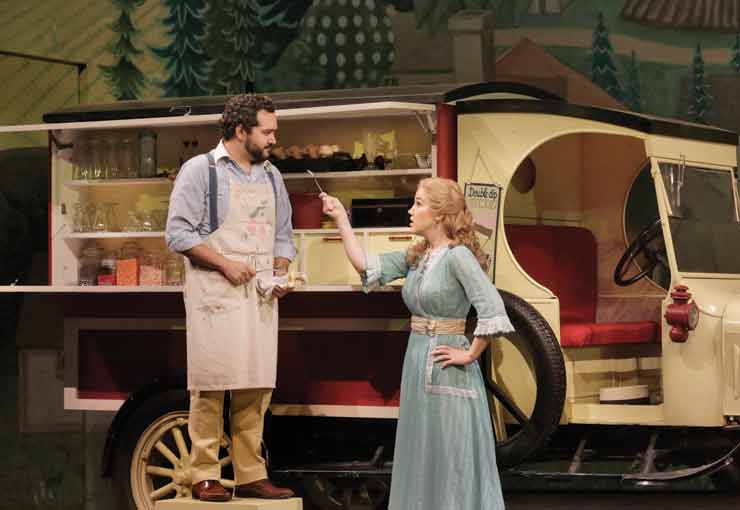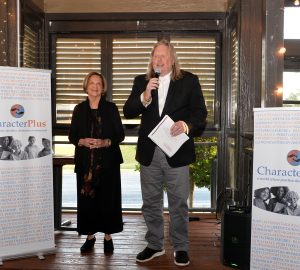Some of the most active theater in town right now is at Opera Theatre of St. Louis—and sometimes opera is not only about singing. That’s especially true of Gaetano Donizetti’s The Elixir of Love. Both a bel canto opera and an opera buffa, it encourages the performers to show off their singing and acting skills.
The original libretto takes place in a small Italian town in the 19th century, where country bumpkin Nemorino has fallen in love with Adina, who is several social levels above him. She’s also courted by a preening military officer who has come to town seeking recruits. As luck would have it, passing through town is a peddler of patent medicines, who sells Nemorino a love potion. Wonder of wonders, it works!
OTSL artistic director James Robinson has moved the setting to a small American town in 1914, and it works like a charm. In this version, Nemorino sells ice cream from his little truck; Adina is the town librarian. Allen Moyer’s set is inspired by Grant Wood and Thomas Hart Benton, and the costumes (originally by the late Martin Pakledinaz) overflow with period Midwestern charm.
In addition to being one of the top tenors in the world right now, Rene Barbera makes a very sweet and touching Nemorino. Susannah Biller, as Adina, matches him vocally in their rocky road to romance. Patrick Carfizzi has fine comic flair as the snake-oil salesman, and Tim Mix could not be more full of himself as the officer. As conductor, OTSL’s Music Director Stephen Lord keeps things bubbling musically.
Showing in repertory, as is its custom, OTSL also gives us Mozart’s The Magic Flute, with leading Mozart expert Jane Glover conducting members of the St. Louis Symphony in the pit. On stage, a menagerie of elements overwhelms the senses in a production concepted by pop designer Isaac Mizrahi. It helps going in to know that all the workmen wandering around and moving set pieces are there because Mizrahi has placed the performance on a movie sound stage. Sound stages, he says, are where magic happens, and The Magic Flute is all about magic. More organic to the opera is Mizrahi’s decision to add professional dancers onstage, as well as dancing animals, which I thought added to the charm. The score is infectious, and brava to coloratura soprano Claire de Sevigne’s agile cadenza, a series of short, fast notes.
New this year and commissioned by Opera Theatre is 27, a reference to the address in Paris where Gertrude Stein and Alice B. Toklas held their salons for the great artistic and literary lights of the early 20th century. Royce Vavrek’s libretto has Toklas, after Stein’s death, remembering their life together and their famous visitors. I’m afraid I found these recollections less interesting than I imagined them (see Woody Allen’s Midnight in Paris), but Ricky Ian Gordon’s score is attractive and accessible. And it’s sung by two major operatic talents, the great Stephanie Blythe as Stein and Elizabeth Futral as Toklas.
Also featuring great voices is Francis Poulenc’s Dialogues of the Carmelites. It has yet to open as I write, but with Christine Brewer as the Prioress and Kelly Kaduce as a troubled young nun, musically it’s bound to be thrilling. And its story of the martyrdom of a convent of nuns during the French Revolution is guaranteed to bring out the tissues.
By Bob Wilcox
Photo by Ken Howard
Pictured: Tenor Rene Barbera, Soprano Susannah Biller







